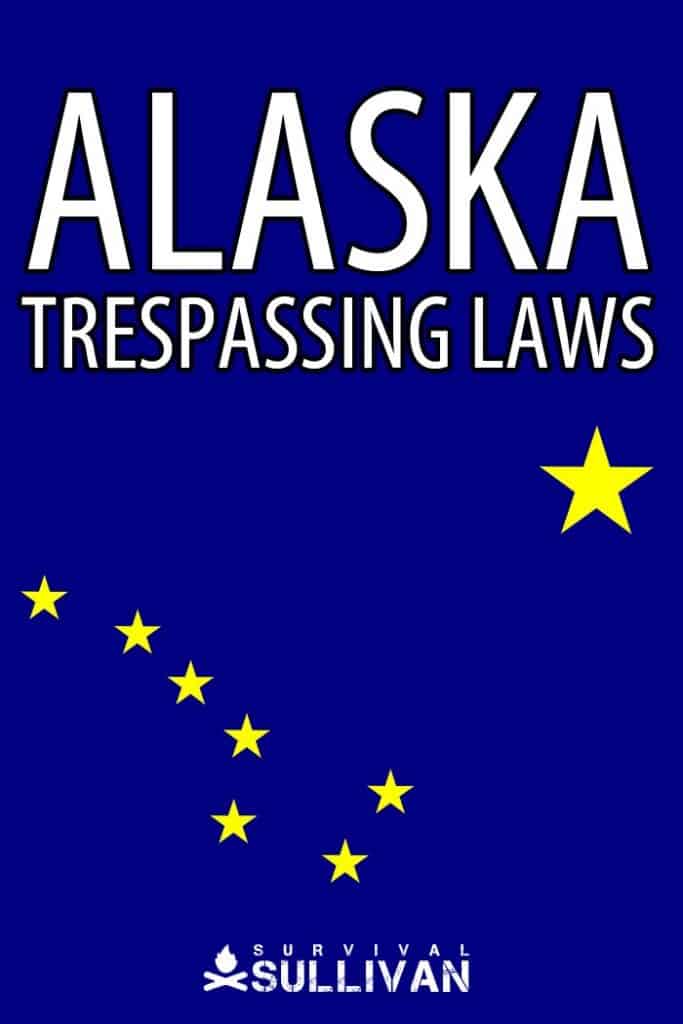Alaska: Fast Facts on Trespassing
Trespass Law Covers: Buildings, dwellings, vehicles, undeveloped land
Crime Class: Misdemeanor
- Fencing Required? No.
- Signage Required? No, if verbal declaration made.
- Verbal Notice Required? No, if “reasonably conspicuous sign posted.”

Alaska Trespassing Law Overview
Alaska is another fairly usual state when it comes to trespass law with one interesting exception: perhaps owing to the sparsely populated nature of the place and its typically harsh environs, Alaska makes allowance for trespass in case of emergency for “immediate and dire need,” so long as the person contacts the owner of the property, the owner’s agent or the nearest available police agency as soon as possible afterward to report the incident.
Full details below.
Relevant Alaska State Statutes
- Section 11.46.320 Criminal Trespass in the first degree
- Section 11.46.330 Criminal Trespass in the second degree
- Section 11.46.340 Defense; emergency use of premises
- Section 11.46.350 Definitions
We normally begin any exploration of the law at the beginning with the legal definitions relevant to the state statutes, but in Alaska’s case we start at the end! That’s where the definitions are in this section, so we’ll jump to 11.46.350 and circle back:
Article 2. Burglary and Criminal Trespass. Sec. 11.46.350. Definition; privilege to enter or remain on unimproved land.
(a) As used in AS 11.46.300 — 11.46.350, unless the context requires otherwise, “enter or remain unlawfully” means to
(1) enter or remain in or upon premises or in a propelled vehicle when the premises or propelled vehicle, at the time of the entry or remaining, is not open to the public and when the defendant is not otherwise privileged to do so;
(2) fail to leave premises or a propelled vehicle that is open to the public after being lawfully directed to do so personally by the person in charge; or
(3) enter or remain upon premises or in a propelled vehicle in violation of a provision in an order issued or filed under AS 18.66.100 — 18.66.180 or issued under former AS 25.35.010(b) or 25.35.020.
(b) For purposes of this section, a person who, without intent to commit a crime on the land, enters or remains upon unimproved and apparently unused land, which is neither fenced nor otherwise enclosed in a manner designed to exclude intruders, is privileged to do so unless
(1) notice against trespass is personally communicated to that person by the owner of the land or some other authorized person; or
(2) notice against trespass is given by posting in a reasonably conspicuous manner under the circumstances.
…
Of note in the section above is Alaska’s language concerning entry and remaining on land that is empty, apparently unused and unbordered by fencing or other enclosure that states doing so, so long as you have no intent to commit a crime, is de facto permission to be on the land! This language is fairly common in many states’ statutes.
Note too that trespass includes a motor vehicle, and also does not depend on any posted signage for legal enforcement if the owner of the property has issued a lawful order telling someone to get out and stay out!
Sections 11.46.320 and 11.46.330 declare the penalty schedule for trespassing:
Article 2. Burglary and Criminal Trespass. Sec. 11.46.320. Criminal trespass in the first degree.
(a) A person commits the crime of criminal trespass in the first degree if the person enters or remains unlawfully
(1) on land with intent to commit a crime on the land; or
(2) in a dwelling.
(b) Criminal trespass in the first degree is a class A misdemeanor.
—
Article 2. Burglary and Criminal Trespass. Sec. 11.46.330. Criminal trespass in the second degree.
(a) A person commits the crime of criminal trespass in the second degree if the person enters or remains unlawfully
(1) in or upon premises; or
(2) in a propelled vehicle.
(b) Criminal trespass in the second degree is a class B misdemeanor.
…
Criminal trespass is either a Class A or Class B misdemeanor in Alaska, the difference being whether or not someone unlawfully entered a dwelling for any reason or land with the intent to commit a crime (Class A) or upon any other premises or a propelled vehicle with no intent to commit a crime (Class B).
Now the interesting part: Alaska provides an affirmative defense to criminal trespassing as charged so long as the accused can prove they did so for “immediate and dire need.” This tidbit is explained in 11.46.340:
Article 2. Burglary and Criminal Trespass. Sec. 11.46.340. Defense: emergency use of premises.
In a prosecution under AS 11.46.300, 11.46.310, 11.46.320, or 11.46.330(a)(1), it is an affirmative defense that
(1) the entry, use, or occupancy of premises or use of personal property on the premises is for an emergency in the case of immediate and dire need; and
(2) as soon as reasonably practical after the entry, use, or occupancy, the person contacts the owner of the premises, the owner’s agent or, if the owner is unknown, the nearest state or local police agency, and makes a report of the time of the entry, use, or occupancy and any damage to the premises or personal property, unless notice waiving necessity of the report is posted on the premises by the owner or the owner’s agent.
…
As speculated above, this law likely came about as a result of Alaska’s seclusion, sparse population, hostile weather and relatively meager communications networks. A person in a serious jam may have no other way to avoid death or disaster except making use of any and all resources available to them whether they own them or not.
Keep in mind that Alaska provides this is an affirmative defense, meaning someone who trespasses under this provision will still see their day in court and have to prove it!
You cannot bust in to someone’s home or vehicle, steal something, and then stroll on scot-free claiming “immediate and dire need” to be in possession of the lifted goods!
How to Obtain a Trespassing Order in Alaska
To obtain an order of no trespass, sometimes called a trespass restraining order, in Alaska you’ll need to have your property posted against trespassing in accordance with state law. Either that or you should directly notify the trespasser verbally or preferably in writing via a certified letter with confirmation of delivery.
With this done, inquire with your local sheriff’s department, police department or district attorney’s office to figure out what forms are required to file the order. Note that you’ll need to have this order re-upped periodically because they don’t last forever!
Rules for Posting No-Trespassing Signs in Alaska
Alaska has specific requirements for no-trespassing signage. Any no-trespassing sign that will have the force of law behind it must have your name and address posted on it, be at least 144 square inches in size and placed at all entrances. Make sure any specific behavioral prohibitions are listed and the sign must be printed in English.
Conclusion
Alaska’s trespassing laws are fairly predictable and inline with many of the rest of the states save their provision for an affirmative defense to trespassing if one does so with an immediate and dire need in an emergency.
Considering how severe and dangerous the state’s terrain and weather can be, that makes sense!


Tom Marlowe practically grew up with a gun in his hand, and has held all kinds of jobs in the gun industry: range safety, sales, instruction and consulting, Tom has the experience to help civilian shooters figure out what will work best for them.

Can a person who is in an official capacity be trespassed if you ask them to leave your property & they refuse?